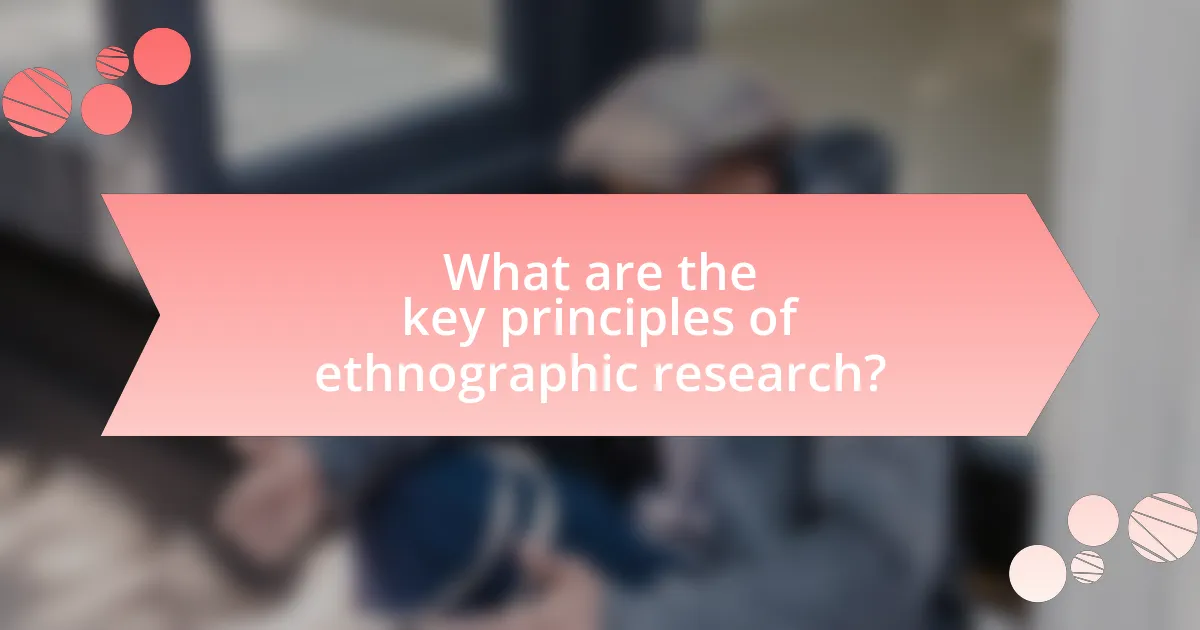Ethnography is a qualitative research method essential for understanding social dynamics by providing in-depth insights into the behaviors, beliefs, and interactions of individuals within their cultural contexts. This article explores the methodologies employed in ethnographic research, such as participant observation and in-depth interviews, and highlights how these techniques reveal hidden social structures and community interactions. It also discusses the importance of ethical considerations, the implications of researcher bias, and the application of ethnography across various fields, including anthropology, sociology, healthcare, and marketing. By examining case studies and best practices, the article emphasizes the role of ethnography in informing public policy and community development initiatives.

What is the Role of Ethnography in Understanding Social Dynamics?
Ethnography plays a crucial role in understanding social dynamics by providing in-depth insights into the behaviors, beliefs, and interactions of individuals within their cultural contexts. This qualitative research method allows researchers to observe and engage with communities, capturing the complexities of social relationships and cultural practices. For instance, ethnographic studies have revealed how social norms and values shape group identities and influence decision-making processes, as seen in the work of Clifford Geertz, who emphasized the importance of thick description in understanding cultural phenomena. By immersing themselves in the daily lives of participants, ethnographers can uncover the underlying social structures and power dynamics that govern interactions, thus offering a comprehensive view of social dynamics in various settings.
How does ethnography contribute to the study of social dynamics?
Ethnography contributes to the study of social dynamics by providing in-depth insights into the behaviors, interactions, and cultural contexts of specific communities. This qualitative research method allows researchers to observe and engage with individuals in their natural environments, revealing the complexities of social relationships and power structures. For instance, ethnographic studies, such as those conducted by Clifford Geertz in “The Interpretation of Cultures,” demonstrate how local customs and practices shape social norms and group identities. By capturing the lived experiences of participants, ethnography enhances understanding of how social dynamics operate within different cultural frameworks, thereby offering a nuanced perspective that quantitative methods may overlook.
What methodologies are employed in ethnographic research?
Ethnographic research employs methodologies such as participant observation, in-depth interviews, and field notes. Participant observation allows researchers to immerse themselves in the community being studied, gaining insights through direct engagement. In-depth interviews facilitate a deeper understanding of individual perspectives and experiences, while field notes document observations and reflections during the research process. These methodologies are essential for capturing the complexities of social dynamics within specific cultural contexts, as evidenced by studies like “The Ethnographic Interview” by James P. Spradley, which highlights the importance of these techniques in gathering rich qualitative data.
How do ethnographers gather data in social settings?
Ethnographers gather data in social settings primarily through participant observation, interviews, and field notes. Participant observation involves ethnographers immersing themselves in the community or social group they are studying, allowing them to experience daily life and interactions firsthand. This method enables them to collect nuanced insights about social dynamics and cultural practices. Interviews, both structured and unstructured, provide ethnographers with direct accounts and perspectives from individuals within the community, enriching their understanding of social contexts. Field notes serve as a critical tool for documenting observations, reflections, and interactions, ensuring that the data collected is comprehensive and detailed. These methods collectively contribute to a robust understanding of the social dynamics at play within the studied environment.
Why is ethnography important for understanding cultural contexts?
Ethnography is important for understanding cultural contexts because it provides in-depth insights into the lived experiences, practices, and beliefs of individuals within a specific culture. This qualitative research method involves immersive observation and participation, allowing researchers to capture the nuances of social interactions and cultural norms that quantitative methods may overlook. For instance, ethnographic studies have revealed how cultural rituals shape community identity and social cohesion, as seen in Clifford Geertz’s work on the Balinese cockfight, which illustrates the interplay between culture and social structure. Such detailed understanding is crucial for accurately interpreting behaviors and social dynamics within diverse cultural settings.
How does ethnography reveal hidden social structures?
Ethnography reveals hidden social structures by providing in-depth insights into the lived experiences and interactions of individuals within their cultural contexts. Through participant observation and immersive engagement, ethnographers can uncover the norms, values, and power dynamics that shape social relationships and hierarchies. For example, in her study “The Cultural Politics of Emotion,” Sara Ahmed illustrates how emotional responses are socially constructed and can reflect underlying power structures, thereby demonstrating how ethnographic methods can expose these often-invisible frameworks.
What insights can ethnography provide about community interactions?
Ethnography provides deep insights into community interactions by capturing the lived experiences, cultural practices, and social norms of individuals within a community. This qualitative research method allows for an in-depth understanding of how people communicate, collaborate, and form relationships in their everyday lives. For instance, ethnographic studies have shown that community gatherings, rituals, and shared spaces significantly influence social cohesion and identity formation among members. By observing and participating in these interactions, ethnographers can reveal underlying power dynamics, social hierarchies, and the impact of cultural context on behavior, thereby offering a comprehensive view of community life.

What are the key principles of ethnographic research?
The key principles of ethnographic research include immersion, participant observation, and contextual understanding. Immersion requires researchers to engage deeply with the community being studied, allowing them to gain insights into cultural practices and social interactions. Participant observation involves the researcher actively participating in the daily life of the subjects, which enhances the authenticity of the data collected. Contextual understanding emphasizes the importance of situating findings within the broader social, historical, and cultural contexts, ensuring that interpretations are grounded in the realities of the community. These principles are foundational in producing rich, nuanced insights into social dynamics, as evidenced by studies like Clifford Geertz’s “Thick Description,” which illustrates the significance of context in understanding cultural phenomena.
How does participant observation enhance ethnographic studies?
Participant observation enhances ethnographic studies by allowing researchers to gain an in-depth understanding of social dynamics through immersive engagement with the community being studied. This method enables researchers to observe behaviors, interactions, and cultural practices in their natural context, leading to richer, more nuanced data. For instance, a study by Clifford Geertz emphasizes the importance of “thick description,” where participant observation provides the context necessary to interpret social actions meaningfully. By actively participating in the daily lives of subjects, researchers can uncover insights that might remain hidden through other data collection methods, thus deepening the overall analysis of social phenomena.
What are the challenges of participant observation in social dynamics?
Participant observation in social dynamics faces several challenges, including researcher bias, ethical dilemmas, and the impact of the observer on the group. Researcher bias occurs when the observer’s preconceptions influence their interpretation of social interactions, potentially skewing data. Ethical dilemmas arise when participants are unaware they are being observed, raising concerns about consent and privacy. Additionally, the presence of the observer can alter group behavior, known as the Hawthorne effect, which can lead to unrepresentative findings. These challenges complicate the reliability and validity of data collected through participant observation in social dynamics.
How does participant observation differ from other research methods?
Participant observation differs from other research methods by involving the researcher actively engaging in the daily life of the subjects being studied, rather than merely observing them from a distance. This immersive approach allows for a deeper understanding of social dynamics, as it enables the researcher to gather nuanced insights and contextual information that other methods, such as surveys or interviews, may not capture. For instance, while surveys provide quantitative data, participant observation yields qualitative insights through direct interaction and experience within the community, enhancing the richness of the data collected.
What ethical considerations are involved in ethnographic research?
Ethical considerations in ethnographic research include informed consent, confidentiality, and the potential for harm to participants. Informed consent requires researchers to fully disclose the nature of the study and obtain voluntary agreement from participants, ensuring they understand their rights and the use of their data. Confidentiality involves protecting the identities and personal information of participants to prevent any negative repercussions from their involvement. Additionally, researchers must be aware of the potential for harm, which can arise from misrepresentation or exploitation of the community being studied. These ethical principles are essential to maintain trust and integrity in the research process, as highlighted by the American Anthropological Association’s Code of Ethics, which emphasizes the responsibility of researchers to prioritize the welfare of their subjects.
How do ethnographers ensure informed consent?
Ethnographers ensure informed consent by providing participants with comprehensive information about the research, including its purpose, methods, potential risks, and benefits. This process typically involves clear communication, allowing participants to ask questions and ensuring they understand their rights, including the right to withdraw at any time. Ethnographers often use written consent forms to document this agreement, which serves as a formal acknowledgment of the participant’s understanding and willingness to engage in the study. This practice is supported by ethical guidelines from organizations such as the American Anthropological Association, which emphasizes the importance of transparency and respect for participants in ethnographic research.
What are the implications of researcher bias in ethnography?
Researcher bias in ethnography can significantly distort the findings and interpretations of cultural phenomena. This bias may lead to misrepresentation of the studied community, as the researcher’s preconceived notions and personal experiences can influence data collection and analysis. For instance, a study by Hammersley and Atkinson (2007) highlights that ethnographers often project their own beliefs onto the subjects, which can skew the authenticity of the insights gained. Consequently, the implications include compromised validity of the research, potential ethical concerns regarding the portrayal of subjects, and the risk of reinforcing stereotypes, ultimately undermining the objective of ethnography to provide a nuanced understanding of social dynamics.

How can ethnography be applied in various fields?
Ethnography can be applied in various fields such as anthropology, sociology, education, healthcare, and marketing to gain in-depth insights into cultural practices and social interactions. In anthropology, ethnography helps researchers understand the customs and beliefs of different societies through immersive observation and participation. In sociology, it reveals the complexities of social structures and relationships by studying communities in their natural environments. In education, ethnographic methods inform teaching practices by examining student experiences and classroom dynamics. In healthcare, ethnography aids in understanding patient behaviors and cultural influences on health, leading to improved care strategies. In marketing, businesses utilize ethnographic research to comprehend consumer behavior and preferences, enhancing product development and marketing strategies. These applications demonstrate ethnography’s versatility in providing valuable qualitative data across diverse disciplines.
What role does ethnography play in anthropology?
Ethnography plays a crucial role in anthropology by providing in-depth insights into cultural practices and social dynamics through immersive observation and participation. This qualitative research method allows anthropologists to gather detailed data about people’s behaviors, beliefs, and interactions within their natural environments. For instance, ethnographic studies, such as those conducted by Clifford Geertz in “The Interpretation of Cultures,” demonstrate how thick description can reveal the complexities of social life, thereby enhancing the understanding of cultural contexts.
How does ethnography inform public policy decisions?
Ethnography informs public policy decisions by providing in-depth insights into the lived experiences and cultural contexts of communities. This qualitative research method allows policymakers to understand the complexities of social dynamics, which quantitative data alone may overlook. For instance, ethnographic studies have revealed how local customs and social networks influence health behaviors, leading to more effective public health interventions tailored to specific populations. Research conducted by the Pew Research Center highlights that ethnographic approaches can uncover the nuances of community needs, enabling the design of policies that resonate with the target audience and improve implementation success.
What are the applications of ethnography in business and marketing?
Ethnography is applied in business and marketing primarily to gain deep insights into consumer behavior and cultural contexts. By observing and interacting with consumers in their natural environments, businesses can identify unmet needs, preferences, and pain points that traditional research methods may overlook. For instance, companies like Procter & Gamble have utilized ethnographic studies to understand household dynamics, leading to the development of products that better fit consumer lifestyles. Additionally, ethnography aids in crafting targeted marketing strategies by revealing how cultural factors influence purchasing decisions, as evidenced by research conducted by the American Marketing Association, which highlights the effectiveness of ethnographic insights in enhancing brand relevance and customer engagement.
How does ethnography enhance our understanding of social change?
Ethnography enhances our understanding of social change by providing in-depth insights into the lived experiences and cultural contexts of individuals within a society. This qualitative research method allows researchers to observe and interact with communities, revealing how social dynamics, values, and practices evolve over time. For instance, ethnographic studies, such as those conducted by Clifford Geertz in “The Interpretation of Cultures,” demonstrate how local customs and narratives shape collective identities and responses to broader societal shifts. By capturing the nuances of everyday life, ethnography uncovers the mechanisms through which social change occurs, offering a comprehensive view that quantitative methods may overlook.
What case studies illustrate the impact of ethnography on social movements?
Case studies that illustrate the impact of ethnography on social movements include the ethnographic research conducted by Clifford Geertz in Indonesia, which highlighted the role of local culture in shaping political activism, and the work of Nancy Fraser, who analyzed feminist movements through ethnographic methods to understand the complexities of gender and social justice. Geertz’s study demonstrated how cultural narratives influenced the mobilization of communities, while Fraser’s research provided insights into the intersectionality of social movements, emphasizing the importance of context in activism. These examples underscore how ethnography can reveal the nuanced dynamics of social movements, informing strategies and enhancing understanding of participant motivations and cultural contexts.
How can ethnographic findings influence community development initiatives?
Ethnographic findings can significantly influence community development initiatives by providing in-depth insights into the cultural, social, and economic dynamics of a community. These findings enable developers to tailor initiatives that resonate with the community’s values and needs, ensuring higher engagement and effectiveness. For instance, a study by the American Anthropological Association highlights that ethnographic research can reveal local practices and beliefs that shape community interactions, allowing for the design of programs that align with these cultural contexts. This alignment increases the likelihood of successful implementation and sustainability of development projects, as evidenced by various case studies where ethnographic insights led to improved community participation and resource allocation.
What best practices should researchers follow in ethnographic studies?
Researchers in ethnographic studies should prioritize participant observation, maintain reflexivity, and ensure ethical considerations. Participant observation allows researchers to immerse themselves in the community, gaining deeper insights into social dynamics. Reflexivity involves critically reflecting on one’s biases and influence on the research process, which enhances the validity of findings. Ethical considerations, such as obtaining informed consent and ensuring confidentiality, are crucial to protect participants and uphold research integrity. These practices are supported by the American Anthropological Association’s Code of Ethics, which emphasizes the importance of ethical conduct in anthropological research.
How can researchers effectively engage with communities during fieldwork?
Researchers can effectively engage with communities during fieldwork by building trust and fostering open communication. Establishing relationships with community members through active listening and respectful dialogue encourages participation and collaboration. For instance, involving local leaders in the research process can enhance credibility and facilitate access to the community. Studies have shown that participatory approaches, where community members contribute to the research design and implementation, lead to more relevant and impactful findings. Engaging in cultural practices and attending community events also demonstrates commitment and respect, further strengthening ties.
What strategies can enhance the validity of ethnographic findings?
To enhance the validity of ethnographic findings, researchers should employ triangulation, member checking, and prolonged engagement. Triangulation involves using multiple data sources or methods to cross-verify findings, which strengthens the credibility of the results. For instance, combining interviews, observations, and document analysis can provide a more comprehensive understanding of the social dynamics being studied. Member checking allows participants to review and confirm the findings, ensuring that the interpretations accurately reflect their perspectives. Prolonged engagement with the community fosters trust and deeper insights, as researchers can observe behaviors and interactions over time, leading to richer data. These strategies collectively contribute to the robustness and reliability of ethnographic research outcomes.
